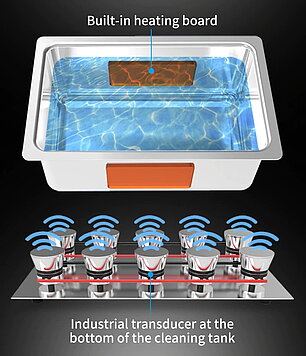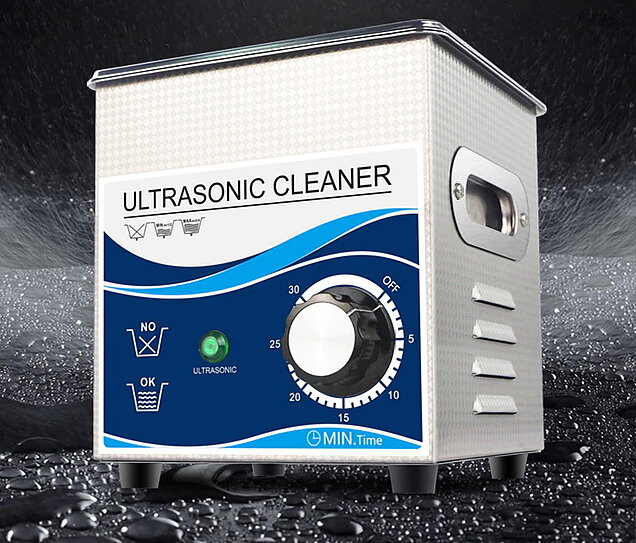What is the difference between laser cleaning and ultrasonic cleaning?
Ultrasonic cleaning uses the direct and indirect effects of ultrasonic cavitation, acceleration and direct flow in the liquid on the liquid and dirt, so that the dirt layer is dispersed, emulsified, and peeled to achieve the purpose of cleaning. At present, the ultrasonic cleaning, cavitation and direct flow effect used in traditional cleaning methods are more used. What is the difference between laser cleaning and ultrasonic cleaning?
The ultrasonic cleaner uses the alternating frequency signal emitted by the ultrasonic generator, which is converted into an alternating frequency mechanical oscillation by the transducer and propagated to the medium-the cleaning liquid. The strong ultrasonic wave is dispersed in the cleaning liquid in the form of dense and dense phases. Wash the object radiation. Produce "cavitation" phenomenon, that is, the form of "bubbles" in the cleaning liquid, resulting in rupture. When the "cavitation" reaches the moment when the surface of the washed object is broken, an impact force of far more than 1000 atmospheric pressure is generated, which causes the dirt in the surface, hole and gap of the object to be dispersed, cracked and peeled off, so that the object can be purified and cleaned.
Laser cleaning technology refers to the use of high-energy laser beam irradiation workpiece surface, make the surface of dirt, rust spots or coating instantaneous evaporation or peeling, high speed and effective removal of cleaning object surface attachment or surface coating, so as to achieve a clean process. It is based on the laser and material interaction effect of a new technology, compared with the traditional mechanical cleaning method, chemical corrosion cleaning, liquid solid strong impact cleaning, high frequency ultrasonic cleaning and other traditional cleaning methods, has obvious advantages.
Ultrasonic cleaning do need a medium like water or detergent. The higher the power density of the ultrasonic wave, the stronger the cavitation effect, The faster the speed, the better the cleaning effect, but for the precise surface finish of very high objects, using a long time of high power density cleaning will produce cavitation, corrosion on the surface of the object, using 50°C~70°C working temperature.
Handheld laser cleaning machine has the advantage of not contacting with the cleaning material. Ultrasonic cleaning method is close cleaning, cleaning the surface of the object has a mechanical force, easy to damage the surface of the object. Laser cleaning is a kind of non-contact processing, which can be conveniently operated from a long distance.
Compared with traditional cleaning methods such as ultrasonic cleaning and chemical corrosion cleaning, laser cleaning has obvious advantages. It is efficient, fast, low-cost, and has low thermal load and mechanical load on the substrate. The cleaning is non-damaging; it does not harm the health of the operator; the cleaning process is easy to realize automatic control and realize remote remote control cleaning.

LASER CLEANING Versus ULTRASONIC CLEAINING
The difference between laser cleaning and ultrasonic cleaning is that the laser cleaning operation is very convenient. Generally, hand-held cleaning is sufficient. The surface of the object can be cleaned directly without any medium. The cleaning effect is very good for large-area cleaning and precision parts cleaning. The working temperature is- 5°C~50°C can be used.
Ultrasonic needs to add cleaning agent. The higher the ultrasonic power density, the stronger the cavitation effect, the faster the speed, and the better the cleaning effect. However, for precision objects with very high surface finish, long-term high-power density cleaning will cause cavitation and corrosion on the surface of the object. The working temperature is 50°C~70°C.
Mould cleaning
Laser provides alternative to ultrasonic baths and blasting
Until now, two systems have been commonly used to clean moulds: ultrasonic baths and blasting with dry ice, peach stones, sand, or other materials. The ultrasonic cleaning method can be considered as expensive, polluting and time consuming. Blast cleaning is very noisy with high costs for difficult-to-store consumables. The SWIPE laser cleaning system eliminates these drawbacks: it provides a fast, safe and ecological solution with a quick return on investment.
Fast-moving laser beams reduce cleaning times
The Swipe Cleaning laser can clean horizontal, vertical or inclined surfaces, and complex shapes. The laser beams can move at 20 to 200 mm per second, depending the power of the laser, thus reducing cleaning times drastically. In addition, moulds can be cleaned while still hot. The cleaning cycle time is cut by 75%, or even more in certain cases.
Simplicity of use, no consumables
The SWIPE machine’s simplicity lies in its simple and fast programming. The machine works with a standard electrical outlet and requires no consumables. The process is non-abrasive, non-polluting, and requires no additives and no specific protection. Residue removed by the laser is vacuumed up and filtered through an activated carbon filter that also removes any odours.
